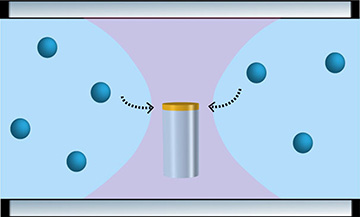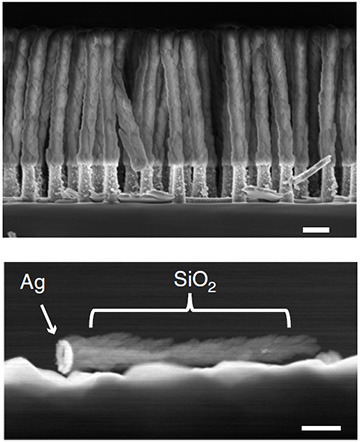
A scheme created by researchers at the Indian Institute of Science (IIS) uses metal nanodisks at the end of silica microrods to create mobile plasmonic tweezers, capable of trapping and maneuvering subwavelength particles with light. [Image: Ghosh and Ghosh, Nat. Commun., doi: 10.1038/s41467-019-12217-2 (2019); CC-BY 4.0]
The Nobel Prize–winning technology of optical tweezers has scored many successes in trapping and manipulating diminutive objects, including biological cells, with light fields. But even optical tweezers have their limitations. Traditional optical tweezers are bound by the diffraction limit, making it difficult to trap subwavelength-size objects such as viruses and colloidal nanoparticles. And the high optical powers needed to hold nanoscale particles in place amid a torrent of Brownian motion risks photo-damage to the specimen itself.
An alternative lies in plasmonic tweezers—the use of nanoscale metal structures capable of concentrating optical energy at subwavelength scales, and thereby capturing particles well below the diffraction limit. Plasmonic tweezers, though, have issues of their own. In particular, the plasmonic concentrators that do the heavy lifting typically are fixed in a specific spot. That makes it difficult to use them in applications such as dynamically snagging and manipulating nanoscale objects in a fluid.
A research team at the Indian Institute of Science (IIS) has now found a clever solution to the problem (Nat. Commun., doi: 10.1038/s41467-019-12217-2). The team’s “tweezer in a tweezer” architecture slaps a metal nanodisk at the end of a glass microrod, creating a mobile, nanoparticle-grabbing plasmonic tweezer that can be maneuvered into place by conventional optical tweezers. The researchers believe that the scheme could find use, for example, in the manipulation and assembly of nanomaterials in standard lab-on-a-chip microfluidic devices.
Plasmonic quandaries
Plasmonic tweezers operate, in principle, the same as conventional optical tweezers, capturing particles using gradient forces set up by a strong light field. But tweezers made of metal plasmonic nanostructures accomplish this at much smaller length scales than conventional tweezers—on the order of tens of nanometers—because of the strong, subwavelength concentration and confinement of electromagnetic energy at the nanostructure’s metal-dielectric interface. The same light concentration means that plasmonic tweezers can be used to capture nanoparticles at much lower overall optical intensities than with conventional tweezers, which reduces the prospect of photo-damage to tiny biological specimens such as viruses.
Unfortunately, the metal structures used to create plasmonic nanotweezers typically are immobile, fabricated on the surface of a fluidic chamber. That means, in essence, that the plasmonic tweezers need to wait for viruses or colloidal nanoparticles in a fluid to come to them, which limits their use for dynamic manipulation of particles in the fluid.
Some researchers have attempted to get past this problem by using optical tweezers to trap and move metallic nanoparticles, such as silver disks, which themselves can then act as mobile plasmonic tweezers for grabbing still smaller specimens. At these small length scales, however, the disks are buffeted by Brownian motion—random fluctuations due to collisions with molecules in the surrounding fluid. Using conventional tweezers to pin the disks in place amid these fluctuations requires high, potentially specimen-damaging optical intensities.
Disk on a rod

Top: the researchers grew an array of silica nanopillars on a wafer substrate; scale bar = 500 nm. Bottom: TEM image of a single active colloidal nanotweezer (ACT) particle, including silica microrod and silver nanodisk; scale bar = 300 nm. [Image: Ghosh and Ghosh, Nat. Commun., doi: 10.1038/s41467-019-12217-2 (2019); CC-BY 4.0]
To get around these challenges, the IIS team, including Ph.D. student Souvik Ghosh and supervisor Ambarish Ghosh, hit upon the idea of attaching the metallic nanodisk to the end of a much heftier dielectric microrod. The microrod would be large enough to stand up to Brownian fluctuations—but small enough to be steered using conventional optical tweezers operating at relatively low intensities. The metallic nanodisk, meanwhile, would act as a plasmonic tweezer at the end of the glass rod, concentrating the same low-intensity optical energy to generate strong near fields capable of capturing subwavelength-scale nanoparticles.
The IIS researchers created a platform for testing out the scheme by first using colloidal lithography and reactive ion etching to create a forest of silica nanopillars, each around 2.5 μm long and 250 nm in diameter, on a silicon wafer substrate, at a density of around 100 million nanopillars per square centimeter. They then deposited a 50-nm thickness of silver on top of the nanopillars, creating slender glass rods capped with 250×50-nm disks of silver. Finally, they immersed the nanopillar forest into a fluid and used sound waves to break them off of the wafer.
Nano-trapping at low intensities
With the resulting solution of metal-capped microrods—which the team calls active colloidal tweezers (ACTs)—Ghosh and Ghosh put the system to the test, in a tweezers setup consisting of a 1064-nm laser source coupled to an inverted optical microscope with a 100×, 1.4 NA objective. They were able to demonstrate the trapping and releasing of 100-nm-diameter fluorescent nanodiamonds, and the trapping, steering and release of 200-nm fluorescent polystyrene nanoballs.
Trapping, transport and release of two 200-nm fluorescent polystyrene nanoparticles using ACTs.
The glass-metal hybrid structure of the mobile tweezers allowed manipulation of the particles to take place at optical powers one to two orders of magnitude lower than previous studies that used tweezers to manipulate metal nanoparticles alone. In a more restricted configuration, the team was able to use the ACTs to grab onto even smaller polystyrene nanoparticles only 40 nm in diameter.
Cargo carriers
In addition to its ability to trap and manipulate nanoparticles below the diffraction limit at low optical powers, the team observes in the paper that the system allows such particles to be actively maneuvered using optical energy alone, and inside standard microfluidic chambers. Those attributes, the team believes, suggest that the ACTs “could be operated remotely to trap and maneuver subwavelength colloidal cargo,” in standard lab-on-chip platforms using optical tweezers.
The technology, the team concludes, “may enable isolation, manipulation, and chip-level assembly of nanomaterials such as nanocrystals, fluorescent nanodiamonds and quantum dots and allow noninvasive manipulation of fragile bio-specimens, such as bacteria, virus, and various macromolecules.”
